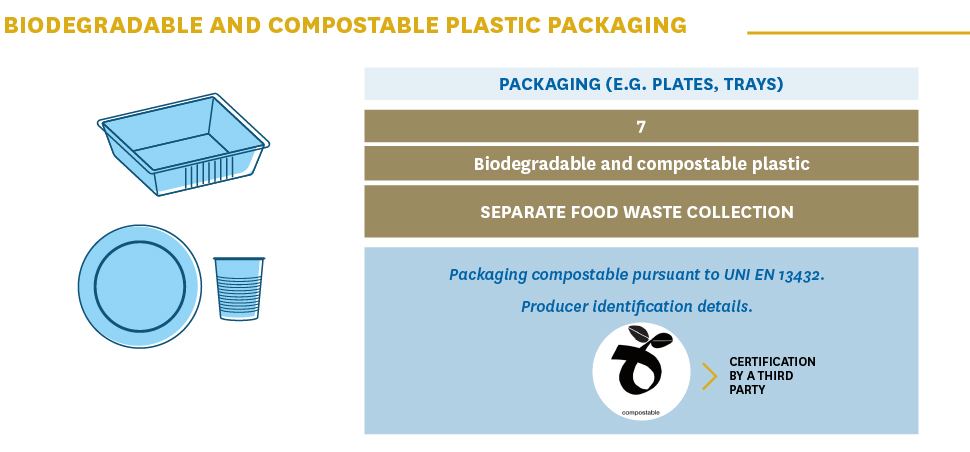Introduction
Recent regulatory changes (Legislative Decree No. 116 of 3 September 2020) that introduced mandatory environmental labelling of packaging have prompted many companies to integrate, modify or affix from scratch the minimum environmental information on their packaging.
CONAI took this opportunity to draw up the Guidelines on environmental labelling of packaging which are intended to be a support for companies in interpreting and understanding the text of the law, as well as an opportunity to clarify aspects and definitions that very often cause confusion.
In this context, many companies are approaching this innovation as an opportunity to review the set of environmental information that can be conveyed through packaging. In addition to the information they are required to put on their packaging, companies are asking themselves how they can clearly, correctly and reliably promote and convey additional environmental characteristics of their packaging.
This is why CONAI has decided to support them in this process with a new work tool that aims to provide an overview of the main environmental declarations and labels that can be voluntarily affixed to packaging, and to explain their objectives and meaning.
The Guidelines for voluntary environmental labelling of packaging therefore aim to guide companies in providing additional environmental information in an unambiguous and proper manner.
Environmental labelling and consumers
Research commissioned by CONAI in 2020 to the Management Institute of the Scuola Superiore Sant’Anna di Pisa, showed that Italian consumers pay attention to the environmental characteristics of packaging and that this tendency is on the increase.
Half of Italians pay attention to the environmental information on packaging and say they often look for it. In particular, one in two consumers frequently look for information regarding the recyclability of packaging, while 44% pay attention to information regarding the recycled content of the pack composition.
The research shows how environmental labels on the pack play an interesting role in informing consumers about the characteristics of the product and the pack itself: for approx. 3 out of 4 respondents, environmental labels provide credible and reliable information on environmental quality, with a positive effect on product perception, so much so that for 60% of them it affects the decision to purchase.
Nevertheless, the study highlights that environmental labels are still poorly understood by consumers, partly because of the heterogeneity and multitude of information and labels conveyed through packaging.
Which information?
The document consists of two sections: a descriptive one and one that contains the answers to the most frequently asked questions we have gathered to date from companies and associations.
The descriptive part presents an overview of the main voluntary environmental labels envisaged for packaging, broken down by label type. In this case, the following is provided:
- the information for high-quality separate waste collection, that the company can voluntarily add to the mandatory indications referring to separate collection of waste packaging intended for end consumers;
- the “Made Green in Italy” national voluntary scheme;
- the product environmental labels, which are those that are part of the ISO 14020 standard, and are divided into 3 types (Environmental labelling types I, II and III);
- the environmental certifications: the main ones concern the certification of compostability, recycled material content and proper forest management linked to the supply of raw material for goods produced in wood and paper;
- Other specific environmental labels for material supply chains, in particular for paper and cardboard packaging in relation to its recyclability, and for metal packaging in relation to communication of the ability of these materials to be permanently recycled;
- Participation in an EPR system, where a trademark is envisaged, in particular for the CONAI, COMIECO and CiAl consortia.
The second part of the document envisages a series of FAQs and practical examples that aim to show which packaging environmental information can be voluntarily included on the label and for what purposes.
The table below summarises the environmental labellings and trademarks described in these Guidelines, classified by purpose and type of material to which they may refer.
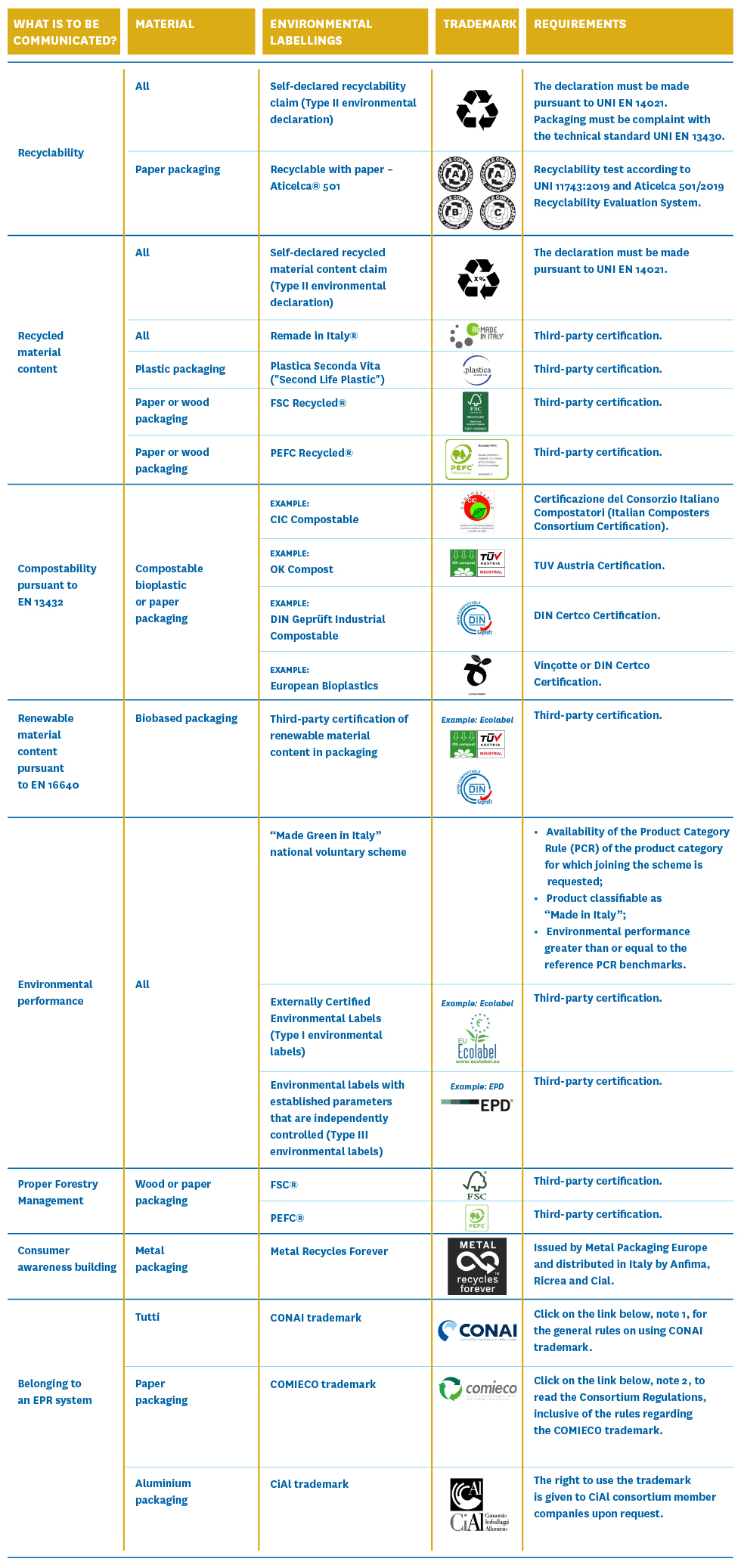
NOTE 1
General Rules On Using The Conai Trademark
NOTE 2
Rules regarding the COMIECO trademark
Additional information for efficient separate waste collection
Since 26 September 2020, packaging intended for the B2C channel, in addition to the alphanumeric coding identifying the material, must also provide indications for the end consumer on proper separate waste collection. This obligation underlines the importance and strategic nature of communication through packaging, which has once again proved to be an ambassador of virtuous values and responsibility towards the environment.
Citizens are thus supported in recognising the materials the packaging is made of in order to identify its destination in separate waste collection, according to the procedures in force in their municipality.
Indeed, in Italy, it is the Municipalities that organise and manage separate collection, depending on the morphology, organisation, logistics and availability of plants in the area. Therefore, these Municipalities adopt different separate collection systems (e.g. street, door-to-door, mixed), according to specific needs, with different collection methods (multi-light, multi-heavy, glass-metal).
Local authorities thus perform their duties within the recycling chain, but responsibility is shared with other parties, without which the cycle would be incomplete. In this regard, citizens play a key role by applying separate collection in their homes, a crucial commitment without which the circular economy would not be possible. Over the years, the results obtained in terms of the quantity of waste collected have been very satisfactory, facilitating a steady increase in recycling performance. In order to be able to do more and do better and to strive further towards even better recycling results that generate valuable secondary raw materials that can be efficiently reintroduced into new production cycles, it is essential that separate waste collection also improves in terms of quality. Citizens can play a substantial role in this, as too can companies, by conveying “instructions” for quality separate waste collection through the packaging they put on the shelves, as well as virtuous messages that effectively raise consumer awareness.
For these reasons, communicating this kind of message to end consumers can help increase their awareness and responsibility, so that they perform simple gestures that can make a difference in terms of the quality of separate waste collection.
For example, given the wide variety of separate waste collection systems and procedures throughout the country, together with proper instruction on where to put the packaging, it is important to recommend that consumers check the regulations provided by the municipality in which they are located so as not to make mistakes.
It is also useful to recommend that consumers empty the packaging of its residual content (unless it is food refuse present in compostable packaging intended for the household food waste collection circuit), although it is not necessary to wash it.
In order to improve and optimise the collection and subsequent phases performed by the operators, it is good practice to ask the consumer to reduce the volume of packaging, especially when it comes to bulky packaging.
If the packaging system consists of several manually separable components made of different materials, it is of absolute importance to clearly instruct the end consumer to separate the components and put them in the right place. Especially when the instructions are all on the packaging or presentation component, it is highly recommended to support the consumer in properly understanding the information, specifying the different packaging components and, for each one, clear information about its composition and proper separate collection.
The Guidelines for environmental labelling include several examples of environmental labelling of packaging which, in addition to the mandatory information, also includes optional instructions for the end consumer for quality separate waste collection.
Moreover, the e-label tool available at http://e-tichetta.conai.org, depending on the packaging selected, proposes certain additional specific information that can be optionally communicated to the consumer for quality separate waste collection.
By way of example, the table below provides a number of indications that can be put on the packaging to aid the consumer in quality separate waste collection.
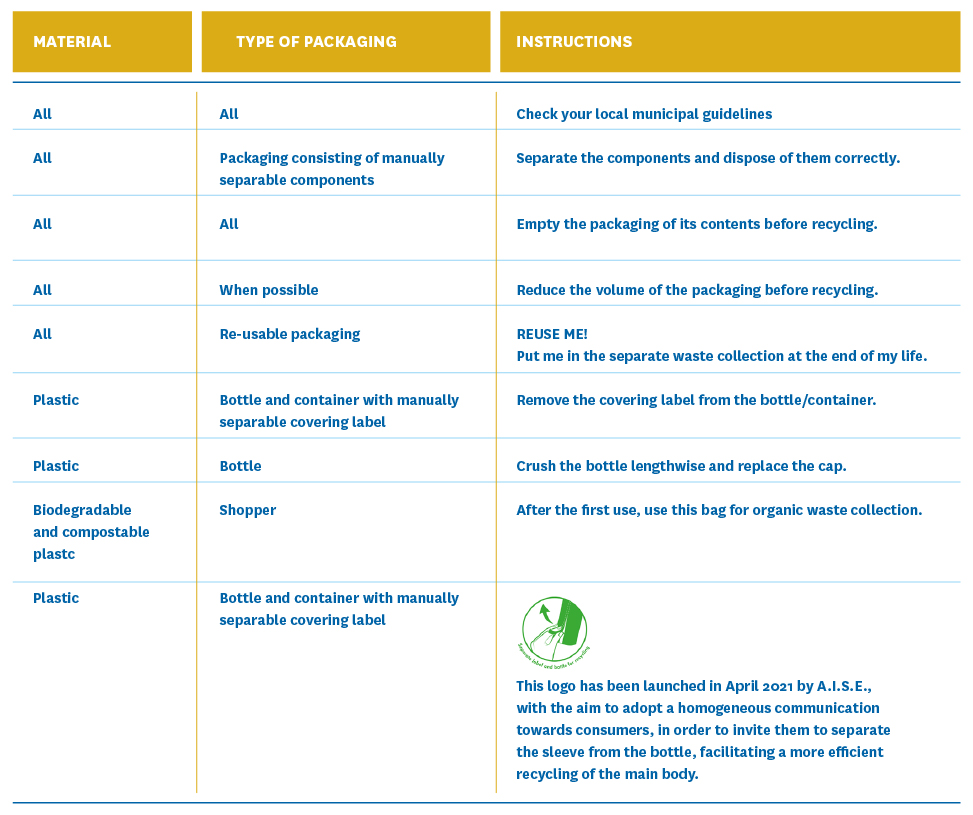
“Made Green in Italy” national voluntary scheme
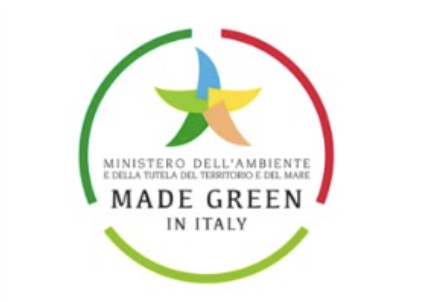 |
The implementation of the scheme involves two phases:
- Phase one: Development of Product Category Rules (PCR)
These are documents containing methodological guidelines that define mandatory and optional rules and requirements necessary to conduct environmental footprint studies for that specific product category. In order for a company to join the scheme, it is essential that PCRs exist for the products for which it intends to join.
Therefore, if a Product Environmental Footprint Category Rule – PEFCR has already been defined at the European level for that product category, this will be transposed in the PCRs; on the contrary, a PCR will be calculated at the national level, following a request to the Ministry of Ecological Transition, according to the foreseen procedures.
- Second phase: joining the “Made Green in Italy” scheme
Products for which there is a valid PCR and which are “Made in Italy” can apply to join the “Made Green in Italy” scheme, by submitting the documentation required in the Regulations.
The product environmental footprint study involves calculating the environmental indicators identified by the related PCR, and an aggregate value of the three main impact indicators, which is then compared with the benchmark defined by the relevant PCR. This comparison allows products to be classified into three possible classes:
- class A, excellent products that perform better than the average product (benchmark);
- class B, products with performance equal to the benchmark;
- class C, products with performance worse than the benchmark.
Class A and B products will be eligible for granted use of the “Made Green in Italy” logo, but those belonging to class B must include an improvement plan to be implemented over the three-year period of validity of such use.
Product environmental labels
The ISO 14020 standard is part of the 14000 series of standards that cover management tools for organisations to track and assess their environmental impact and improve their performance.
In particular, the 14020 standard addresses the communication of environmental characteristics and performance of products, classifying voluntary environmental labelling into three categories: Type I, Type II, and Type III environmental labels.
Environmental labelling aims to inform end consumers and in general the public or private customers on the environmental characteristics and qualities of the products offered. For the packaging sector, environmental labelling is always voluntary.
Type I environmental labels – externally certified environmental labels
These are voluntary labels based on the life cycle approach and require compliance with certain standards in order to be issued. The product/service for which it is requested is subject to third-party certification. The reference standard is UNI EN ISO 14024:2001 (Environmental Labels and Declarations – Type I Environmental Labelling – Principles and Procedures).
These types of labels include, for example, the European ECOLABEL ecological quality label.
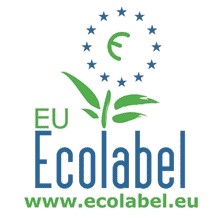 |
EU Ecolabel is the European Union’s eco-label that distinguishes products and services characterised by a reduced environmental impact during their entire life cycle.
It was established in 1992 by Regulation (EEC) no. 880/1992 and is currently regulated by Regulation (EC) no. 66/2010 as amended by Regulation (EU) no. 782/2013. It is in force in the 28 countries of the European Union and in the countries belonging to the European Economic Area – EEA (Norway, Iceland, Liechtenstein).
Being a voluntary Type I label, it has the following characteristics:
- It is based on scientific criteria that address environmental impact throughout the product’s life cycle, along with its functionalities and performance;
- The criteria must have minimum or threshold values;
- Compliance with the criteria is assessed by an independent third-party body, the Ecolabel and Ecoaudit Committee.
The ECAT Register (Ecolabel Catalogue) includes the list of products (goods and services) that have obtained a licence from a competent European body to use the EU Ecolabel, in force, and of the related companies.
Lists of accredited Italian tests and laboratories are available on the website of ACCREDIA.
Type II environmental labels – Self-declared environmental claims
Environmental self-declarations, also called Type II environmental labels, are declarations through which the producer communicates the environmental characteristics of the packaging to the market.
UNI EN ISO 14021 regulates the environmental claims self-declared by companies on their products, and concerns not only the information that in this case is provided through the pack itself, but also that communicated through other channels, such as the Internet or advertising in general.
The standard is useful to packaging producers and users that want to communicate the environmental characteristics of their packaging in a clear, transparent, and non-misleading manner, defining a set of requirements and indicating commonly used terms for voluntary communication of environmental information.
The Type II Environmental Declaration is prepared directly by the company and does not require verification of the information contained. Nevertheless, to demonstrate greater credibility of the declarations, the company may choose to require validation by a third-party body through appropriate verification.
Some examples of communication of self-declared packaging environmental characteristics by the producer may include recyclability, use of recycled material, reduction in resource use, reusability, waste reduction, design for long-term use or disassembly, etc.
The false friends of environmental declarations
Very often, environmental declarations of products – and therefore also of the packaging – are misleading, deceptive, unreliable or unverifiable. This is when we talk of “greenwashing”. This practice often generates confusion in consumers who, being the recipients of too many extremely heterogeneous and unclear messages, end up partially or totally losing confidence in the environmental messages that brands convey to them.
Moreover, one must bear in mind that the Italian Competition Authority has the power to evaluate and apply sanctions for unfair commercial practices, such as advertisements, and therefore for unfair and misleading green claims.
UNI EN 14021 has precisely the objective of harmonising the environmental self-declarations of products, in order to communicate only correct, demonstrable, truthful, and scientifically valid messages.
Examples of “greenwashing” to be avoided
- “100% recyclable”
A package is either recyclable or it is not. The recyclability of packaging is linked to the existence of an industrial recycling process. The technical reference standard is UNI EN 13430: compliance with the principles of this standard is synonymous with packaging recyclability. Nevertheless, it should be noted that packaging cannot be half or one-third recyclable: its characteristics make it recyclable or non-recyclable. When declaring the recyclability of a package, it is not permissible to affix a percentage that measures it. - “Sustainable/ecological/low-impact/zero-impact packaging”
Declarations that do not include reliable information to support what is claimed are incomplete. One needs to find the right way to transfer this information in the right form to the end consumer. It is essential that there is scientific data and criteria underlying everything declared. - Use of unofficial and/or self-made labels to communicate packaging sustainability
Proliferation of environmental labels and messages leads to increased consumer confusion. It is important to refer to a standard in order to adopt the language and a code that is unambiguous and comprehensible for consumers. - “Eco-friendly/environmentally friendly/green/natural packaging”
Messages conveyed to the end consumer must be clear, meaningful, and not vague and meaningless.
Declaration of recyclability and recycled material content
The standard allows the optional use of symbols to make environmental claims. The standard does not define any specific symbol with the exception of the Mobius Loop, which is used for claims relating to packaging recyclability and recycled material content.
The symbol, without percentage share, indicates the recyclability of the packaging, while with the percentage share it provides information about the amount of recycled material contained in the packaging compared to the total composition.
The reference standard for the methodology of monitoring the recycled material content in packaging is CEN CR 13504:2000.


In order for packaging to be declared recyclable, it must comply with EN 13430 and, therefore, it must meet the criteria for suitability for existing recycling technologies, namely:
- existence of an efficient recycling technology for the type of packaging;
- existence of a critical mass so that an efficient recycling process may be managed;
- existence of a market for recycled materials.
These criteria must be assessed via specific surveys and studies.
Self-declared claims may be verified and certified by an accredited certification body to ensure greater reliability of such declarations. On the Accredia website it is possible to consult a database in which the accredited bodies and laboratories are listed.
To support companies that wish to communicate the recyclability of packaging and, to this end, to find out information on the existence of consolidated sorting and recycling supply chains throughout the country or those under development, CONAI provides three main tools:
- Design for Recycling. Packaging Design for Recycling Guidelines, available at progettarericiclo.com
- CONAI EcoD Tool. This is the packaging eco-design tool made available to consortium member companies by CONAI. The tool, based on the simplified LCA analysis, suggests possible improvement actions for the user on the different phases of the packaging life cycle in order to improve its environmental profile. In particular, based on the characteristics and design of the packaging, the tool generates an assessment of the recyclability of the packaging and suggests certain actions for the user to improve the packaging in order to make it more recyclable.
- Lists of the contribution levels of the CONAI diversified Environmental Contribution for plastic packaging.
CONAI has envisaged diversification of the Environmental Contribution according to packaging recyclability. To this end, four packaging recyclability categories have been created, for each of which the value of the CONAI Environmental Contribution has been defined, which is lower for more recyclable packaging.
The lists are available at the following link and are useful to verify which packaging there is a sorting and recycling chain for, and which can therefore be defined as recyclable.
Errors to be avoided
The Mobius Loop, as already explained, makes it possible to communicate an environmental characteristic of packaging: i.e., its recyclability, which consists of the possibility of reusing the material, obtained downstream of the packaging recycling process, in new production cycles. Recyclability must not be confused with the possibility of packaging being put in separate waste collection. In fact, regardless of recyclability, all packaging can be put in separate waste collection. The Mobius Loop with no percentage share is therefore not used to notify the consumer that the packaging can be put in separate collection, but indicates its recyclability.
The Mobius Loop is often confused with other similar symbols, so care must be taken to ensure that the labels are used correctly to avoid mistakes.
For example, the Mobius Loop is often confused with the symbols envisaged by CEN/CR 14311:2002 to identify plastic polymers. Indeed, over the years, the identification of packaging material – not a legal requirement before 26 September 2020 – has been widely adopted by companies, in the different ways provided for by various rules and regulations. Numerous types of packaging have been labelled with symbols referring to the CEN/CR 14311 report (with plastic polymer encodings within arrows forming a triangle). Although these solutions have become consolidated market practice for the identification of such packaging materials, the regulation clearly states that packaging materials should be identified by adopting Decision 129/97/EC and not other existing references or practices. Moreover, the three arrows accompanied by the code do not indicate the recyclability of the packaging.
Another mistake is to create an incorrect “mix” of the two symbols.
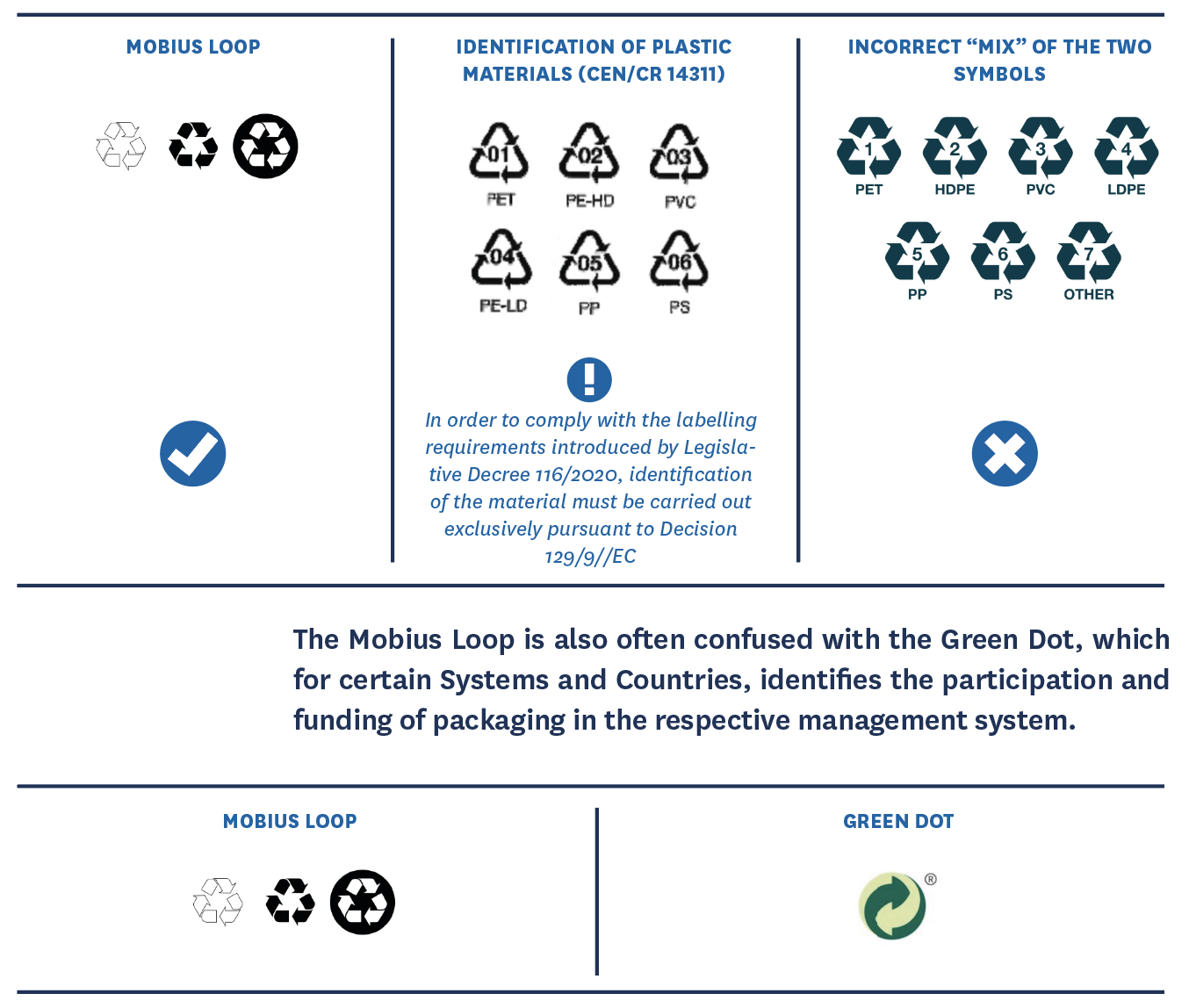
Type III environmental labels – Environmental labels with established parameters that are independently controlled
Type III environmental declarations describe the environmental impact characteristics of a product based on its entire life cycle, through the LCA (Life Cycle Analysis) approach based on rules established for the specific product category.
Products for which these labels are required are subject to third-party verification by an accredited certification body. These include, for example, “Environmental Product Declarations” or EPDs.
The reference standard is UNI EN ISO 14025: 2010 (Environmental Labels and Declarations – Type III Environmental Declarations – Principles and Procedures).
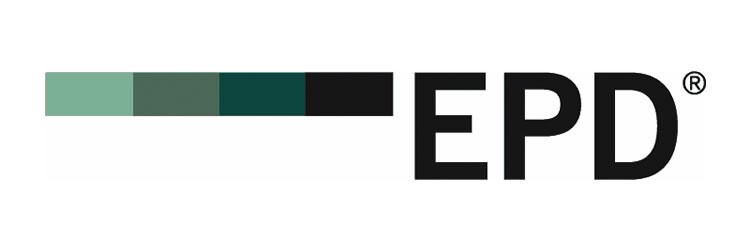 |
The Environmental Product Declaration (EPD) describes the environmental impacts of producing a specific quantity of a product or service.
The Declaration is voluntary and is based on the approach of the analysis of the life cycle of a product or service, therefore on a LCA (Life Cycle Assessment) study, used to define the consumption of resources (e.g. water, energy, raw material) and the impacts on the environment in each phase of the life cycle of the product/service. The results are expressed through environmental indicators, such as GWP (Global Warming Potential).
The LCA must follow certain rules defined by the PCR (Product Category Rules), which also define indications for the EPD itself, which must comply with ISO 14025.
The EPD is always subject to verification by a certification body accredited by ACCREDIA.
Published EPDs are available on the website www.epditaly.it.
Environmental certifications
Product certifications are issued by accredited third-party bodies. The accreditation of these bodies takes the form of a procedure that certifies their independence and impartiality by the Single National Accreditation Body, which in Italy is Accredia. On the Accredia website it is possible to consult a database in which the accredited bodies and laboratories are listed.
Biodegradability and compostability certifications and labels
Compostability certification of is issued by accredited third-party bodies pursuant to the harmonised European standard EN 13432 and certifies that which the packaging directive 94/62 defines as packaging recoverable in the form of compost, i.e. organically recyclable (in composting/anaerobic digestion) together with organic household waste.
In order to be able to also put the biodegradable and compostable packaging waste (and other items) into organic waste collection, Legislative Decree 116/2020 amended Article 182-ter of Legislative Decree 152/2006 (organic waste): in particular, paragraph 6 of the aforementioned article establishes that waste, including packaging waste, having similar biodegradability and compostability properties to organic waste, must be collected and recycled together with the latter if:
a) it is certified by accredited bodies as compliant with European standard EN 13432 for packaging recoverable through composting or biodegradation, or with European standard EN 14995 for other non-packaging items;
b) it is appropriately labelled and states:
- mention of compliance with the above European standards,
- identification details of the producer and certifier,
- appropriate instructions enabling consumers to put such waste in the organic waste separate collection and recycling circuit.
When is packaging considered compostable?
Packaging is considered biodegradable and compostable when it complies with the UNI EN ISO 13432 technical standard. This is the harmonised European standard which, within the framework of the packaging directive 94/62, specifies the “Requirements for packaging recoverable through composting (...)”.
These accredited bodies or laboratories, in order to issue the certificate of conformity with EN 13432, verify that the packaging in question possesses the characteristics established by the standard, i.e.:
- to biodegrade at least 90% in 6 months (i.e., at least 90% of the organic carbon constituting the material must be converted into carbon dioxide);
- if in contact with organic materials for three months, the mass of the material must consist of at least 90% of fragments smaller than 2 mm (to be verified according to EN 14045);
- the material must not have negative effects on the composting process;
- low concentration of heavy metals added to the material;
- pH values, salt content, volatile solids concentrations, and contractions of nitrogen, phosphorus, magnesium, and potassium must be below established limits.
Certain certifiers operating in Italy, together with the biodegradability and compostability certification, also issue specific labels that can be affixed to the packaging certified.
- The Italian Composters Consortium which, together with Certiquality, certifies biodegradable and compostable products with its “CIC Compostable” label.
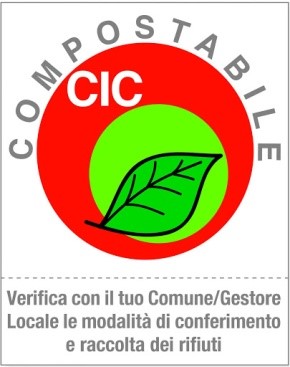
- The TUV Austria group which issues the “OK Compost” label
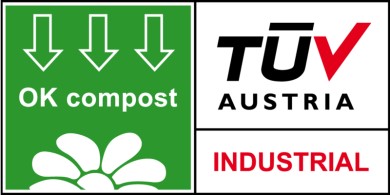
- DIN Certco which issues the “DIN Geprüft Industrial Compostable” label
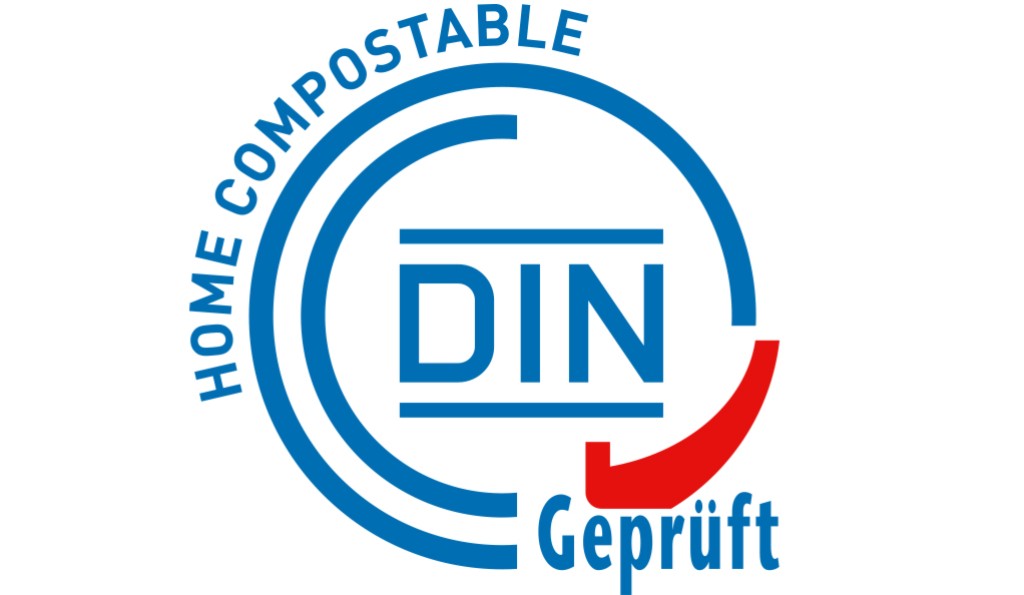
- The European Bioplastics Association which is certifiable by both Vinçotte and DIN Certco.
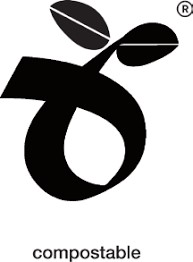
Renewable raw material content certification
For biobased products, the content of renewable material can be measured by the radiocarbon method according to EN 16640 which defines test methods for determining the biobased carbon content of products.
Recycled material content certifications
In addition, there are also certifications on the recycled material content, in accordance with which the use of certain labels can be granted. The most common are Remade in Italy®, Second Life Plastic, FSC Recycled®, PEFC® Recycled.
For all packaging materials
Remade in Italy® is an accredited certification in Italy for verifying the content of recycled material in a product. It certifies the traceability of production within the supply chain, starting from verification of the origin of incoming raw materials, up to the finished product.
Further information is available at: www.remadeinitaly.it
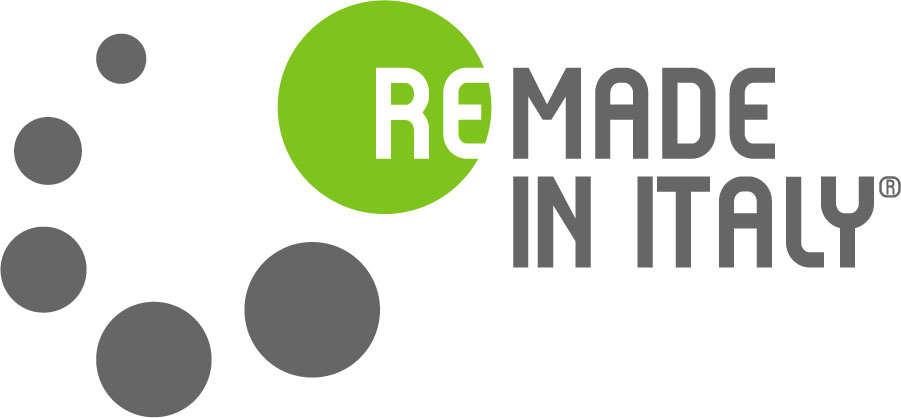 |
For plastic packaging
The “Second Life Plastic” label is an environmental product certification system dedicated to materials and products obtained from the exploitation of plastic waste.
Further information is available at: www.ippr.it
|
|
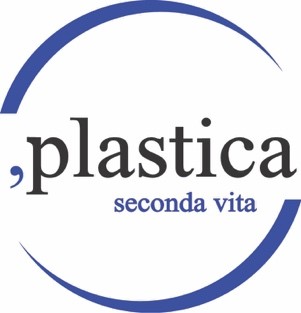 |
For paper or wood packaging
The FSC Recycled® label states that the wood or paper of which the product is made comes from recycled material.
Further information is available at: it.fsc.org
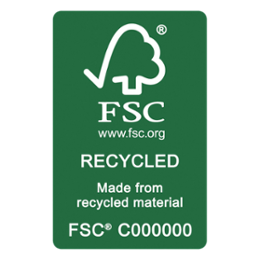 |
The PEFC® Recycled label states that at least 70% of the paper or wood in the product comes from recycled sources. The remaining material must be PEFC certified or from PEFC controlled sources.
Further information is available at: www.pefc.it
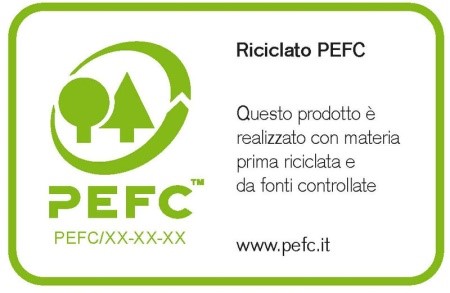 |
Proper forest management certifications
 |
- FSC certification guarantees that the product comes from a responsibly managed forest and supply chain; therefore, to obtain it, the essential rules of responsible forest management must be complied with.
FSC issues three types of certification:
- Forest Management: issued to forest managers and owners whose management practices meet the requirements of the FSC Principles and Criteria.
- Chain of Custody: guarantees FSC-certified material and derived products throughout the supply chain, from the forest to the store.
- Controlled wood: In order to meet the growing demand for certified material, the FSC system has an input category which, while not certified, can provide sufficient guarantees to companies and consumers that they meet certain minimum criteria established by the Forest Stewardship Council.
Further information is available at: it.fsc.org.
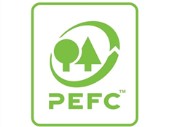 |
- PEFC certification provides a guarantee on origin from sustainably managed forests of the forest or tree origin material contained in a product, through traceability of the certified raw material throughout the supply chain up to the finished product. It is issued by an independent third-party certification body.
There are different types of PEFC Chain of Custody certification:
- individual PEFC certification;
- group PEFC certification, in which several independent companies join together to streamline the paperwork for individual certification;
- PEFC project certification, useful for construction companies to demonstrate their choice to build with PEFC certified timber.
Further information is available at: www.pefc.it
Other specific environmental labels for material chains
For paper and cardboard packaging
Technical standard UNI EN 11743:2019 and the Aticelca 501/2019 Recyclability Evaluation System.
Companies wishing to assess the recyclability of their paper packaging may ask a laboratory to perform a recyclability test, which simulates the main steps of the industrial paper recycling process, in accordance with the procedure defined by UNI 11743:2019.
The outcome of the test allows the recyclability level of the packaging to be identified according to the Aticelca 501/2019 recyclability evaluation system.
The system also makes it possible to communicate the level of recyclability obtained through the use of the special “Recyclable with paper – Aticelca® 501” label.
Further information is available at: aticelca.it
 |
For steel or aluminium packaging
Metal Recycles Forever
With the aim of raising awareness among end consumers of the importance of properly managing metal packaging so that it can be recycled an infinite number of times and become raw material for new production processes, the Metal Recycles Forever logo was created in 2015.
The logo, issued by Metal Packaging Europe and distributed in Italy by Anfima, Ricrea and Cial, has been translated into several languages and disseminated throughout Europe, unambiguously communicating the benefits and importance of proper separate collection of metal packaging.
Further information is available at: https://www.metalrecyclesforever.eu/.
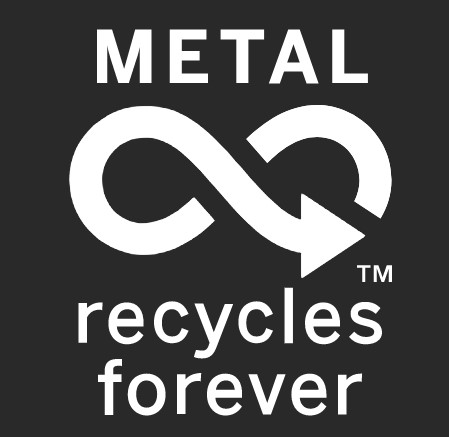 |
Participation in an EPR system
CONAI trademark
Companies producing and using packaging can communicate their membership in CONAI - Consorzio Nazionale Imballaggi (National Packaging Consortium) by placing the CONAI trademark on their packaging.
The right to use the trademark is given, free of charge and upon request, to companies producing or using packaging, as defined in articles 35, paragraph 1, letters q) and r) of Decree 22/97, who have joined CONAI and have complied with the Consortium’s statutory and regulatory requirements.
The application procedure includes:
- submission to CONAI of a special application form signed by the legal representative of the member company concerned;
- evaluation by CONAI of the member company’s eligibility;
- signing the license agreement;
- registration of the agreement in the register of licensees held by CONAI.
COMIECO trademark
Click here to read the Consortium Regulations, inclusive of the rules regarding the Comieco trademark.
CiAl trademark
The right to use the trademark is given to CiAl consortium member companies upon request.
What to include and how
How do I declare the recyclability of my packaging?
It is possible to declare the recyclability of packaging when it complies with the UNI EN 13430 technical standard.
This is a self-claim of the packaging producer, which is therefore responsible for what is declared, and must do so in the manner provided by UNI EN ISO 14021 regulating environmental self-declarations.
This standard also envisages a symbol to communicate the recyclability of the packaging: the Mobius Loop.

Self-declared claims may be verified and certified by an accredited certification body to ensure greater reliability of such declarations.
Example
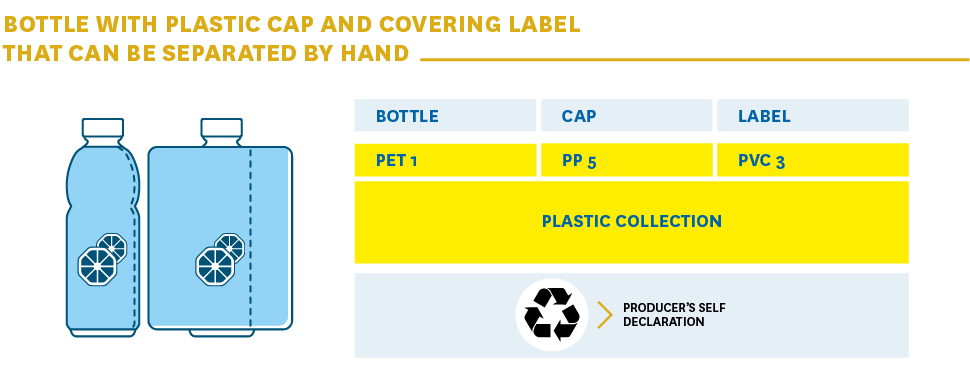
If the packaging is a mainly paper-based composite material, its recyclability can be assessed by a recyclability test, which simulates the main steps of the industrial paper recycling process, in accordance with the procedure defined by UNI 11743:2019. The outcome of the test allows the recyclability level of the packaging to be identified according to the Aticelca 501/2019 recyclability evaluation system.
The system also makes it possible to communicate the level of recyclability obtained through the use of the special “Recyclable with paper – Aticelca® 501” label.
 |
Example
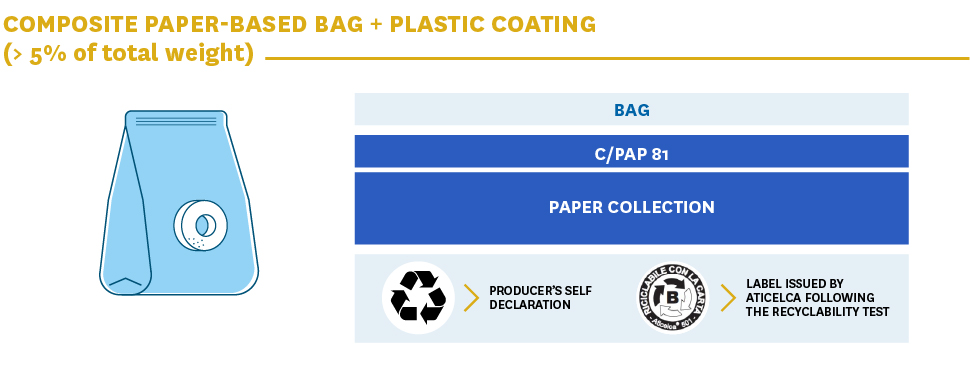
How can I declare that my packaging is made from secondary raw material (recycled material)?
The claim of recycled material content in the packaging can be declared by the pack producer pursuant to the UNI EN ISO 14021 technical standard that regulates environmental self-declarations.
This standard envisages the use of the Mobius Loop symbol accompanied by a percentage that defines the amount of secondary raw material constituting the weight of the pack.

Self-declared claims may be verified and certified by an accredited certification body to ensure greater reliability of such declarations.
Example
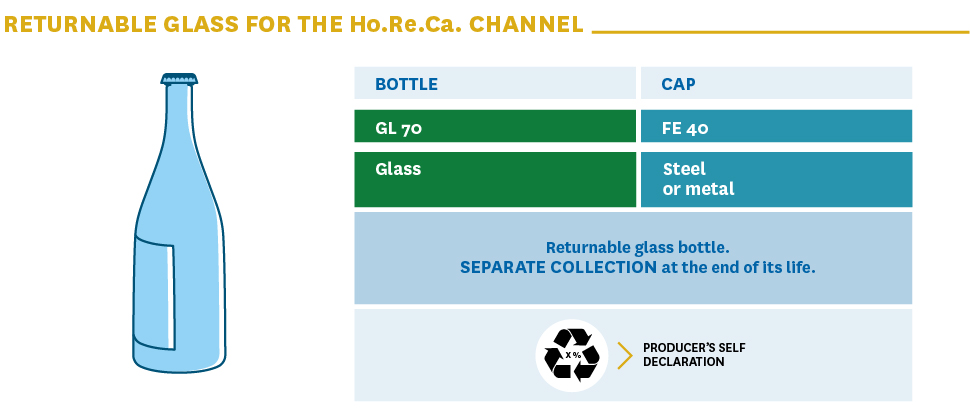
If, on the other hand, the intention is to communicate the presence of recycled material in the composition of the packaging through certification by an accredited third party and the respective label, there are several possibilities:
- For packaging of all materials: Remade in Italy®
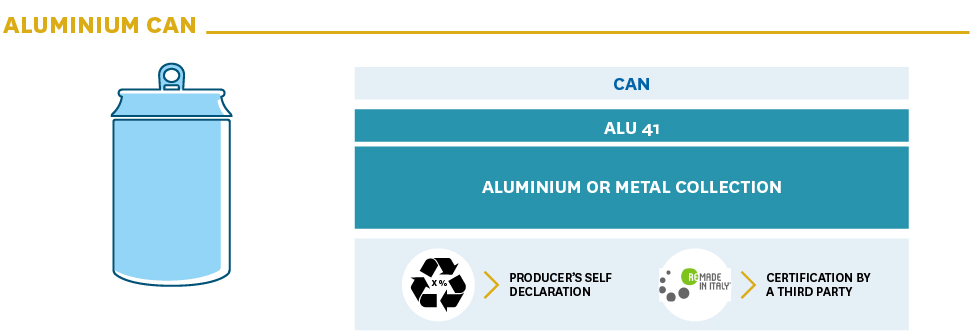
- For plastic packaging: Plastica Seconda Vita ("Second Life Plastic")
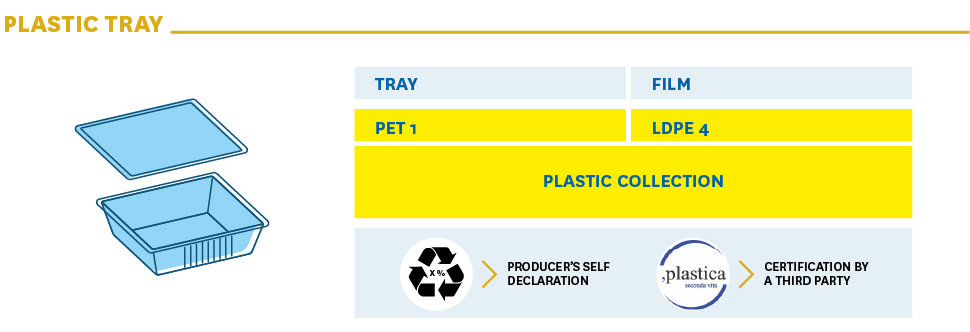
- For paper or wood packaging: FSC Recycled® and PEFC Recycled®
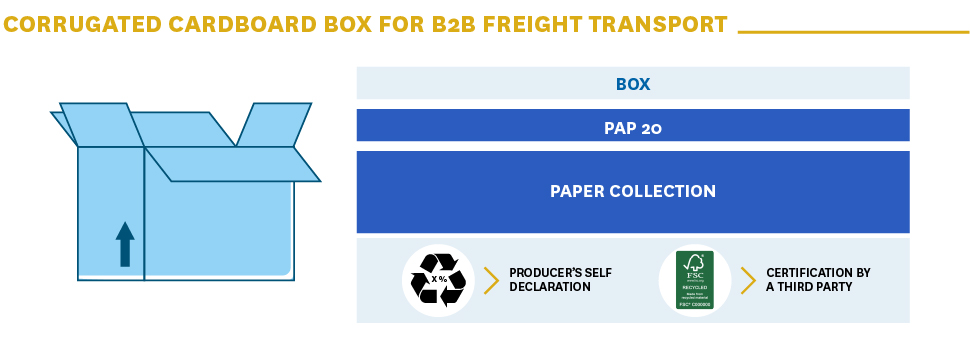
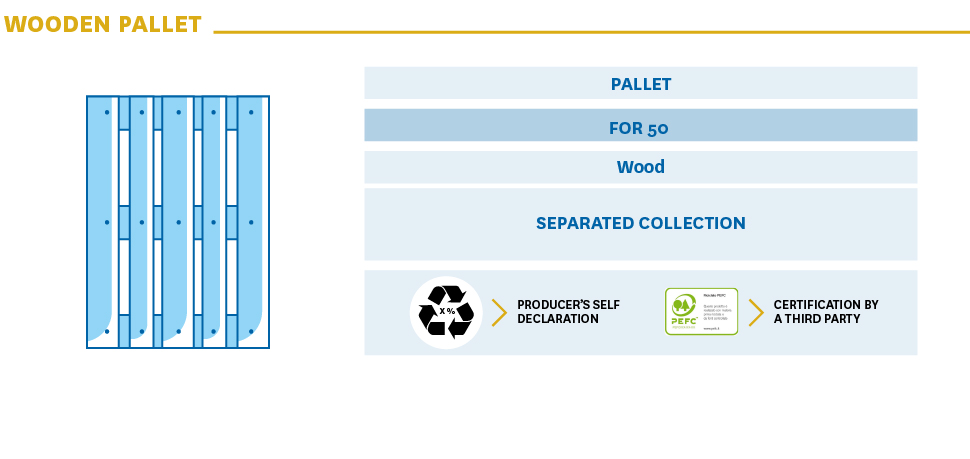
How can I declare that my packaging is compostable?
Packaging can be declared to be compostable when it is certified by certification bodies as complying with the UNI EN 13432 technical standard.
Together with the certification of compostability, the third-party accredited body also grants the use of the special label that attests to achievement of the certification.
Below are the main label-logos of the certification bodies:
- The Italian Composters Consortium which, together with Certiquality, certifies biodegradable and compostable products with its “CIC Compostable” label.
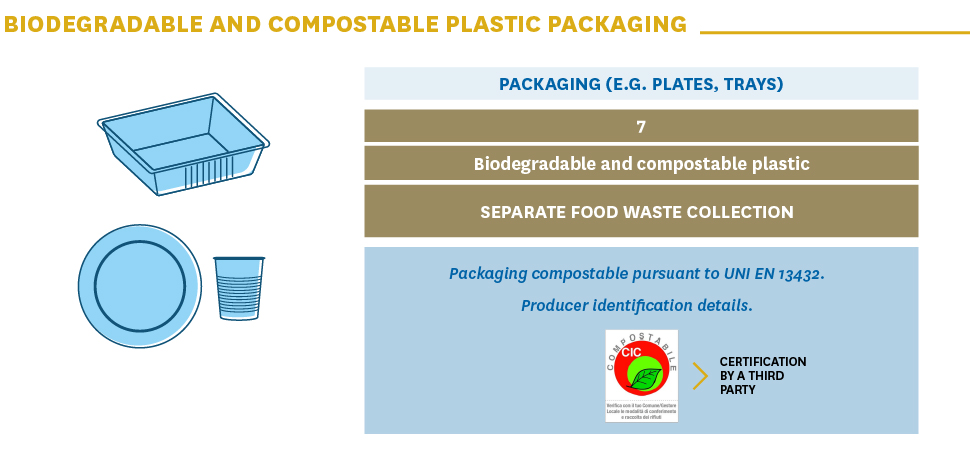
- The TUV Austria group which issues the “OK Compost” label
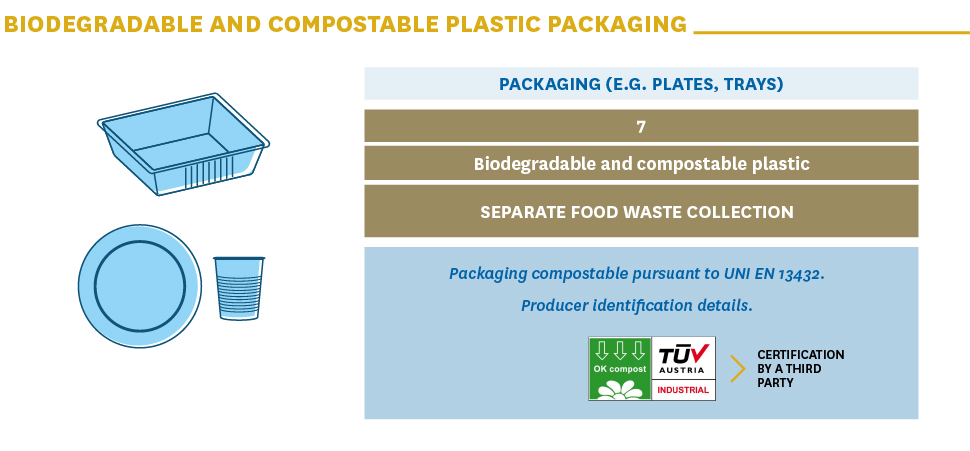
- DIN Certco which issues the “DIN Geprüft Industrial Compostable” label
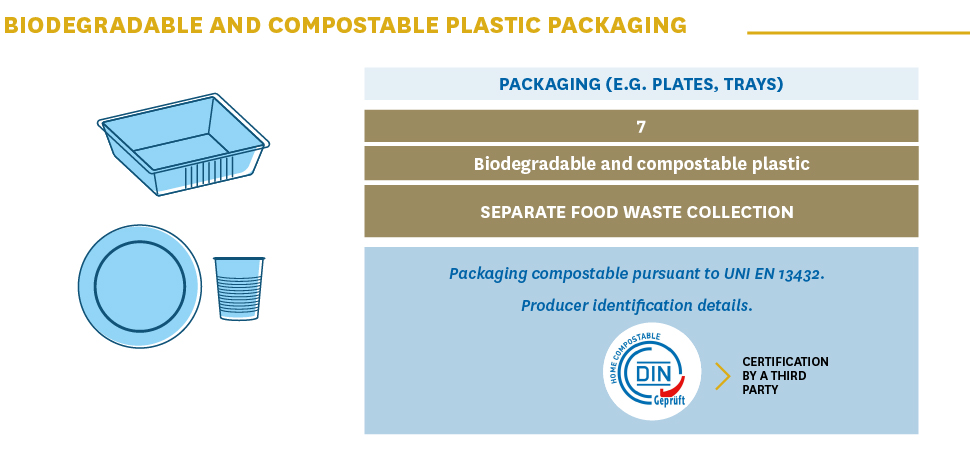
- The European Bioplastics Association which is certifiable by both Vinçotte and DIN Certco.
